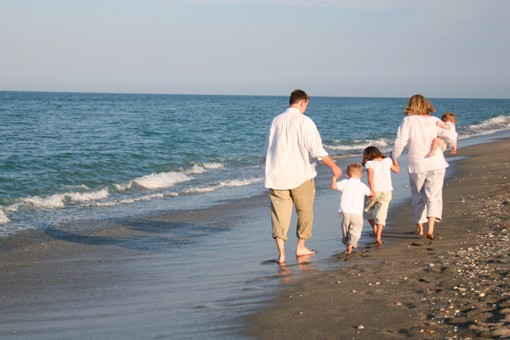 Enjoy hassle-free family holidays with our tips on how to travel with young children – whether you’re taking your baby to the seaside or your tot on a child-friendly summer break.
Enjoy hassle-free family holidays with our tips on how to travel with young children – whether you’re taking your baby to the seaside or your tot on a child-friendly summer break.When planning your destination, be realistic about distances and weather. Tots are happier on beach holidays where they can play freely than on sight-packed city breaks. Disney’s queues, life-sized characters and rides can be overwhelming, even scary, for really little ones, so save the treat until they’re older.
If you’re driving, factor in breaks and have motion-sickness tablets handy. Plan meals at least an hour before and after travel so your child’s stomach can settle. When flying, allow ample time at the airport and pack your child’s favourite teddy bear, toy or book in your hand luggage. A dummy or chewy sweet helps alleviate ear pressure. Some airlines offer baby-changing and bottle-warming facilities.
A lightweight collapsible pushchair is invaluable for toddlers, though a sling is better for exploring with babies. Remember to pack items you might not find on holiday, like children’s cutlery, baby shampoo, sun block and a travel changing mat. Bring a baby monitor for peace of mind.
Fill an easy-to-access daypack with essentials like sun cream, nappies, wet wipes, dummies, bibs for drips and spills, and a change of clean clothes. Use a cool box to store milk, baby food and drinks in hot climates. Sealable plastic bags are ideal for healthy kids’ snacks like cereal, raisins, fruit and crackers.
It’s wise to take a first-aid kit for those little emergencies. Pack things like plasters, tweezers, a thermometer, calamine lotion and rash cream. Take clearly labelled prescription medications in your hand luggage.
Check the hotel’s facilities before booking. Family-friendly hotels often allow young children to sleep for free in their parents’ room and may provide cots and baby alarms. Look for amenities that will appeal to toddlers like a swimming pool with a splash area, playground and crèche. All-inclusive hotels can be a good deal, cutting costs on extras like drinks and ice cream. Choose self-catering apartments for flexible meal times.
Keep an eye out for child-friendly restaurants with high chairs or booster seats, kids’ menus or half portions, and baby-changing facilities. Hotel reception staff can often make recommendations. Unfamiliar foods can upset little tummies, so avoid ingredients like chilli, garlic and pungent spices. Choose a restaurant with a play area to give you and your child a break.
Be flexible is the golden rule of how to travel with young children. Don’t cram too much into the day and allow time for naps. Whatever your interests, think twice before dragging tots around the Louvre or up a mountain. Sure, kids enjoy zoos and aquariums, but they’re often equally content with simple activities like playing in the park or building sandcastles.
Children’s sensitive skin is particularly prone to sunburn in hot climates. Keep kids in the shade with a parasol or beach tent and liberally apply total sunblock every couple of hours. Little ones will be cooler with an SPF50 sunsuit, wide-brimmed sunhat and wrap-around sunglasses. Give your child plenty of water or diluted juice to prevent dehydration.
Bring a small selection of toys and games. Hand puppets, picture books and coloring materials are great for amusing tired or fidgety kids. Inflatable toys and buckets-and-spade sets can often be bought on holiday.